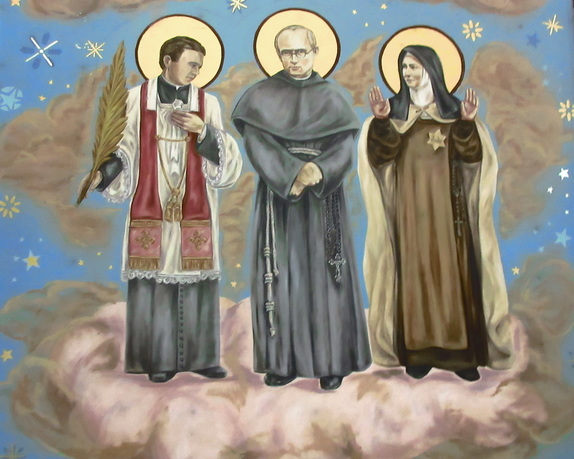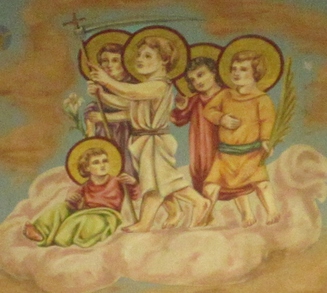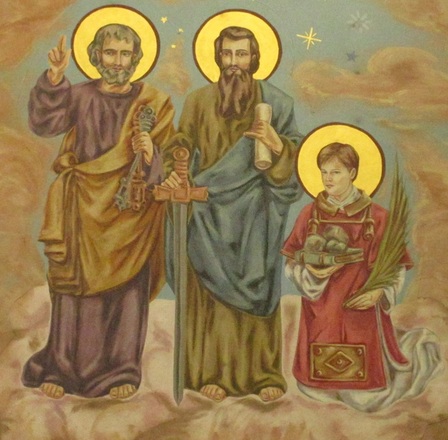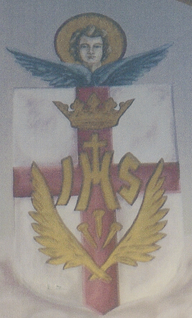Our Altar Mural
Sometimes we pass by something and don’t recognize the beauty that is present. Sometimes we observe something but fail to understand the history and struggle that has been put forth by those who came before us. In this country we have much to be thankful for, including our freedom of speech and the ability to worship as we choose.
The martyrs have paved the way for us by making the ultimate sacrifice by dying for their faith. To them, their expression of their faith was more important than their lives. One way of recognizing those who we admire is to portray them in art. Religious art is said to be an expression of the soul rising up to praise God for all that he has done. With all the negative role models we have around us in the entertainment industry today it is heartening to know that God, through his creation, has provided us with a multitude of role models in the saints and martyrs that we can all seek to imitate.
The goal of this project is for us to have a deeper appreciation of the mural treasure that is before us each Sunday which depicts the martyrs that came before us. Hopefully this will lead us to a better understanding of our past brothers and sisters in the faith, so that we can aspire to their courage, fortitude, and undying faith.
The martyrs have paved the way for us by making the ultimate sacrifice by dying for their faith. To them, their expression of their faith was more important than their lives. One way of recognizing those who we admire is to portray them in art. Religious art is said to be an expression of the soul rising up to praise God for all that he has done. With all the negative role models we have around us in the entertainment industry today it is heartening to know that God, through his creation, has provided us with a multitude of role models in the saints and martyrs that we can all seek to imitate.
The goal of this project is for us to have a deeper appreciation of the mural treasure that is before us each Sunday which depicts the martyrs that came before us. Hopefully this will lead us to a better understanding of our past brothers and sisters in the faith, so that we can aspire to their courage, fortitude, and undying faith.
MARY & THE SAINTS
|
Mary Queen of Martyrs and a shield with a symbol of the Blessed Mother
Revelation 12:1-2, 5 “A great sign appeared in the sky, a woman clothed with the sun, with the moon under her feet, and on her head a crown of twelve stars. She was with child and wailed aloud in pain as she labored to give birth. She gave birth to a son, a male child, destined to rule all the nations with an iron rod. Her child was caught up to God and his throne.” Mary was an only child. She grew up loving God very much. Out of all the woman in history, God choose Mary to be the mother of His own Son, Jesus. When God’s angel asked Mary if she would be the mother of Jesus, Mary answered yes. As his mother, she was at Jesus’ side when He was born in a stable in Bethlehem. She was with him when He suffered and died on the cross. In heaven, Mary was crowned Queen because she was the mother of Jesus, mother of all saints, and mother of the Church. That makes her our mother too. She is shown crowned with 12 stars and with the moon under her feet. Mary is the Queen of Martyrs because she prayed for them so that they could be strong and have courage to state their belief in Christ without fear. |
|
Angel Holding a Palm Branch
Before Christian times the palm was a symbol of victory. It was used by the early Christians, and became a symbol of the victory of the faithful over the enemies of the soul. It was especially a symbol for martyrs who were victorious by being brave, courageous, and for dying for their faith. It would often be said of a martyr that "he received the palm of martyrdom." The palm, when found on a catacomb tomb (early Christian underground burial tombs) was proof that a martyr was present in the tomb. |
Angel holding a crown
The angel is holding a crown for our queen. The crown is given to Mary because she is a perfect follower of Christ. Mary's Queenship can only be understood as a gift of her son as she participates in his love. The titles "king" and "queen" are often used loosely, for those that excel in some way. Thus we call the lion the king of beasts, the rose the queen of flowers. Surely Our Lady deserves the title richly for her saying “yes” to God’s plan. Revelation 2:10 “Be faithful until death, and I will give you the crown of life.” |
|
Father Jerzy Popieluszko
Father Jerzy Popieluszko was a popular young parish priest in a suburb of Warsaw, Poland. Thousands wanted to hear his Sunday sermons. He spoke out against the bad things the government was doing to his people and he supported the Solidarity labor union in the 1980’s. The government feared the Solidarity union and it was forbidden by them. Father Popieluszko was appointed as chaplain to the striking steel workers in Warsaw. The Solidarity movement which Father Popieluszko was associated, was 10 million strong. It was a peaceful, but effective, resistance to the Soviet regime. This movement would eventually free Poland and, along with other forces, lead to the break up of the Soviet empire. Father Popieluszko had been repeatedly accused of crimes and hassled by the police. Workers from the Warsaw steel mills had to take turns protecting him. In the first half of 1984 alone, he was questioned by the police 13 times. On October 19, 1984 Father Jerzy Popieluszko was returning from some pastoral work to his parish in Warsaw. He was taken by the police on his way back. Father Popieluszko was tortured and martyred that night. Estimates vary, but it is believed that at his funeral 400,000 Poles showed up to honor him. Father Popieluszko's death illustrates how some have sacrificed their lives for the kind of freedom and human rights that we often take for granted. Saint Edith Stein Edith Stein was born the youngest of eleven children in a Jewish family in Breslau, Germany in 1891. Edith loved knowledge and was constantly reading as a child. Edith discovered the beauty of the Catholic faith and converted to the faith when she was older. On New Years Day 1922, Edith Stein was baptized into the Catholic Church. Like Saint Teresa of Avila, who Edith admired, Edith felt called to be a Carmelite nun, although she would not enter the convent until 1933. The year 1930 saw the beginning of many religious persecutions across Germany. Edith wanted to do something to help her people. She went so far as to ask if she could speak to the Pope about the way the Jewish people were being treated. Edith Stein became a nun in 1933 and lived in the Carmelite convent at Cologne from 1933 to 1938. In 1938 the situation in Germany had become so bad that many of Edith’s family members left the country in search of safety. Because Edith was a Jewish convert her safety was feared for by her superior at the convent, and she was transferred to a convent in Holland. Throughout this time, Edith spiritually united herself to the suffering of the Jewish people, her people. She is depicted on the mural with the Star of David, which symbolizes her unity with the Jewish people. While in Holland, the Nazis arrested all Jewish Catholics living in Holland. Edith was sent to a concentration camp in Auschwitz. Edith Stein was a woman of faith, bravery, and was very smart. She was martyred in the camp and Pope John Paul II declared her to be a saint. |
Saint Maximilian Kolbe
Maximilian was born in Poland in 1894. As a young man, Maximilian went to Rome to study to become a priest. He was ordained a priest and became very sick with tuberculosis and returned back to Poland. He never complained about being sick, nor did it interfere with his work. Everything was going great until World War II started. Adolph Hitler, the leader of Germany, wanted Germany to rule the world. Hitler’s Army were called the Nazis. The Nazi’s invaded Poland and took over the country. Hitler disliked many people, including Catholic priests. One day Father Kolbe was arrested. He was sent to one of the worst prison camps, called Auschwitz. Prisoners sometimes thought that the only way to stay alive was to try to escape. When this happened, some of the other prisoners would be punished. The Nazis would pick several prisoners. These people would have to die as a punishment because someone had tried to escape. Almost everyone was afraid that he would be picked to die. On July 31, 1941, a prisoner tried to escape from the prison camp. The Nazis began to pick ten men who would have to die. They picked the men and started to lead them away. All of a sudden, one of the prisoners who had been picked, Francis, stopped and began to cry. Francis begged them to not kill him because he had a wife and children, but the Nazis didn’t listen or care. All of a sudden, Father Kolbe stepped out of line and asked to speak to the prison commander. Father Kolbe asked that he be allowed to die in the place of Francis. He explained that he had no wife or children and that Francis was much stronger and could do more work. The commander agreed and Father Kolbe was led away. After the war was over, the survivors of this camp spread the story of Father Kolbe and how he gave up his life for a stranger. Father Kolbe will be forever remembered for his last act of charity. In 1982 Pope John Paul II declared Father Maximilian Kolbe a saint in the presence of the man whose life had been saved. |
|
Holy Innocents
King Herod waited for the wise men to report back to him after their journey to worship Jesus, the new born King. He soon found out that the wise men had already gone back to their home. Herod feared the newborn King would be more powerful than himself and because the wise men had not returned, he became very angry. He sent his soldiers to Bethlehem and commanded them to kill all the little children in Bethlehem who were 2 years old or younger, just to be sure that he would kill Jesus. What a cry went up to God from the mothers of these children, who were torn from their mother’s arms and killed by Herod’s soldiers. The soldiers did not kill Jesus, because Joseph was warned in a dream to take the Holy Family to Egypt for safety. These first martyrs who gave their lives for Jesus are called the Holy Innocents. |
|
Saint Joan of Arc
Joan of Arc was a shepherdess who lived a quiet life with her simple family. At that time, her homeland France was being overrun by British soldiers. As Joan prayed for the freedom of her homeland and the safety of the French soldiers, she began hearing God’s voice telling her to go and save her country. She was given some soldiers, and a special flag was made for her with the words: "Jesus: Maria". At first, she could not believe God could be asking her to wear armor and ride a horse into battle. Yet the voices continued to urge her, so she led the fearful French soldiers on to victory. She won battles that were seen as miraculous. Then she herself crowned Charles VII King of France in his palace. When the king was crowned, Joan asked to be allowed to return to her family, but the king refused. In 1431 some of the jealous soldiers turned her over to the enemy who burned her to death. |
|
Saint Peter
Peter’s real name was Simon. Simon was an expert fisherman. He was a powerful person, but sometimes he had a bad temper. Jesus chose him to lead His apostles when He changed his name and said “you are Peter and on this rock I will build my Church. Peter is pictured holding keys. Jesus gave Peter the keys to the kingdom of heaven. The keys symbolize the authority Jesus gave to Peter. Jesus preached from Peter’s fishing boat, and cured Peter’s mother-in-law when she was sick. Jesus took Peter with Him wherever he went. Peter had his weaknesses. When things became difficult, Peter might talk bravely, but he did not always act so. When Jesus was put on trial, Peter did not go into the court but stayed in the yard. When one of the women there asked Peter if he was a follower of Jesus, Peter denied it. He lied to save himself. Immediately, Peter was sorry, and Jesus forgave him. At Pentecost, God sent the Holy Spirit into Peter, and Peter was never afraid to tell the truth again. He was crucified in Rome. |
Saint Paul
Before Paul had met Jesus, he had been called Saul. He was a smart man, full of energy and emotion. He always acted with great intensity and held his beliefs very strongly. At first he hated Jesus and persecuted Christians. One day, riding on a horse, he was knocked to the ground by what seemed like a lightning bolt. During the next few days he began to believe in Jesus, was baptized, and his name was changed to Paul. He went from city to city telling everyone that Jesus is Lord. Wherever Paul went, he started new communities of Christians. He taught them to be like a large family that belonged to Jesus. Paul is pictured with a scroll in his hand which symbolizes the many letters Paul wrote to these Church communities instructing them and encouraging them. Paul’s love for Jesus was like a fire that burned in his heart. Paul wrote that “the word of God is the sword of the spirit” (Eph 6:17). He is shown holding the sword of martyrdom. In Rome, Paul’s enemies put him in prison, where he died by the sword in the year 67. |
Saint Stephen
Stephen became one of the first deacons in the Church. He and six others were ordained deacons by Jesus’ first Apostles. The deacon’s task was to live a holy life and to help care for the poor in the Christian community. Stephen also had a gift for teaching and doing wonders. Because of his powerful preaching about Jesus, some of the Jews became angered and brought him before the Jewish court. Standing in front of everyone, Stephen spoke bravely and with great wisdom. People said a halo appeared around Stephen’s head, and his face looked angelic. When Stephen said, “I see heavens opened and the Son of Man standing at the right hand of God,” an angry crowd stoned him to death. As Stephen was dying, he asked God to forgive them. He is pictured holding the stones of his martyrdom. Stephen was the first martyr for Jesus. |
|
Saint Maria Goretti
Maria Goretti, a patron saint of youth, was born on a farm in Italy in 1890. Her mother described Maria as happy, kind, and never disobedient. Maria’s father died when she was nine, so she learned to watch the children and do housework, while her mother ran the farm. When Maria was eleven years old, a neighbor’s teenage boy, Alexander, made advances at her with evil intentions. She refused, but never told her mother about the incident. Alexander continued his advances, and she continued to resist. But one day in anger he attacked her with a knife and mortally wounded her. Dying in the hospital, Maria told the priest that she forgave Alexander and wished for him to be in Paradise with her. Alexander had a vision in prison of Maria carrying an armful of lilies, she is pictured holding them. This vision eventually led to Alexander becoming a Christian. |
Saint Stanislaus of Krakow
Saint Stanislaus was both a bishop and martyr. He was born in the diocese of Krakow, Poland in 1030. He is the patron saint of Poland and the city and Diocese of Krakow. He was born into a noble family who gave him a good religious education. After the death of his parents he gave his large inheritance to the poor. He had limitless energy for doing what was right and stood up for the Church’s teachings, regardless of what could happen to him. Stanislaus had several serious arguments with the new king, King Boleslaw. These arguments were about the king’s cruelty. Moreover, the bishop had several arguments with the king over a piece of land belonging to the Church that the king claimed as his own. Also, the king had kidnapped the wife of a noble man, for which Stanislaus verbally condemned him. Stanislaus prayed and told the king to live a more Christian life. The king became furious with Stanislaus. King Boleslaw had his guards follow Stanislaus with orders to kill him. These guards were afraid to obey their order, so King Boleslaw slew the Saint himself while Stanislaus was celebrating Mass. Saint Stanislaus was made a saint and forever will be remembered for standing up for what is right. |
Saint Isaac Jogues
Isaac Jogues was one of eight Jesuits from France who came to America to bring the teachings of Christ to the Indians. Isaac was ordained a priest in 1636, and soon was sent to Canada to do missionary work among the Huron Indians. The peaceful Huron’s were often attacked by the warlike Iroquois tribe. During an attack, Isaac and many of the Huron’s were captured, tortured, and beaten. Isaac escaped to New York, and boarded a ship back to France. He soon returned to the New World to resume his missionary work among the Huron’s. On his way, however, he was captured by a Mohawk war party and beheaded by tomahawk in 1646. Pictured below his feet is a tomahawk. All of the eight Jesuit companions were martyred by Indians in the New World. They wanted to teach the Indians of God’s love, even at the cost of their own lives. |
|
Shield with a monogram of the Sacred Heart of Jesus
The heart is a symbol of love. With Jesus’ heart he loved, suffered, and died for us. From His heart sprang mercy and forgiveness. From His heart he cured, had compassion, and healed. Jesus’ heart has infinite love for us, and we adore this. We return love for love. |









